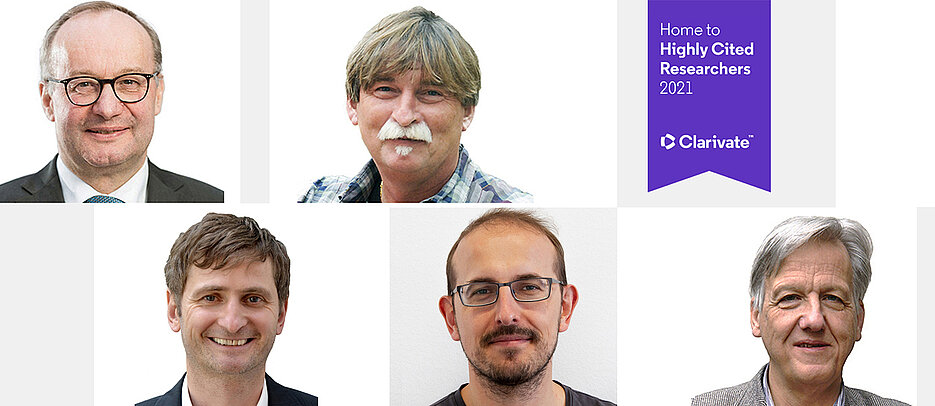Their work is most frequently cited in publications of other scientists. Four researchers from the University are therefore included in the Highly Cited Researchers 2021 List.

Once again the following three professors of Julius-Maximilians-Universität Würzburg (JMU) in Bavaria, Germany, are on the list of Highly Cited Researchers: the medical scientist Hermann Einsele, the biophysicist Rainer Hedrich, and Jörg Vogel, a specialist in RNA research and infection biology. The cell researcher Dr. José Pedro Friedmann Angeli is on the list for the first time.
The current Highly Cited List was established by Clarivate Analytics, a company specialising in citation data, and published on 16. November 2021. The analysis is based on the Web of Science database. For their 2021 assessment, the analysts looked at the time between 2010 and 2020.
Highly cited papers rank in the top one percent of most-cited publications in their field in the year of publication. Only such scholars who have co-authored multiple highly cited papers may join the ranks of “Highly Cited Researchers” comprising some 6,600 scientists worldwide in 2021.
Physicist among the Citation Laureates
In addition to the list of Highly Cited Researchers, Clarivate Analytics publishes the list of so-called “Citation Laureates” which are considered likely to win the Nobel Prize in their respective field. The Wuerzburg physicist, Laurens Molenkamp, has been on this list since 2014. To be eligible for the list, a scientist’s published papers must be cited more than 1,000 times. Moreover, their work must concern a trail-blazing discovery or revolutionary progress which the analysts consider worthy of a Nobel Prize.
JMU President congratulates
JMU President Paul Pauli congratulates the researchers: “The fact that Wuerzburg scientists are repeatedly among the Highly Cited Researchers and Citation Laureates is impressive proof of the international visibility of our university. The honourees are among the most cited researchers in their field worldwide. Congratulations!”
Prof. Dr. Hermann Einsele
The head of the Chair of Internal Medicine II and director of the Medical Clinic and Polyclinic II is an expert in stem cell transplantation against blood cancer and multiple myeloma and infectious diseases in immune-compromised patients. Immunotherapeutic studies for many tumour diseases are underway under his direction. Einsele has developed a cancer therapy with specifically modified immune cells and used it clinically for the first time in Europe. He has received the 2003 van Bekkum Award of the European Society for Cell and Stem Cell Therapy, 2012 Nobel Lecture Stem Cell Biology/Transplantation, Nobel Forum Karolinska Institute Sweden. In 2014 he was accepted as a member of the Academy of Sciences and Literature Mainz. He is co-spokesperson of the Collaborative Research Centres 124 and 338 and spokesperson of the National Centre for Tumour Diseases WERA with headquarters in Würzburg.
Dr. José Pedro Friedmann Angeli
The Junior group leader at the Rudolf Virchow Center for Integrative and Translational Bioimaging at the University of Wuerzburg is a pioneer in the field of ferroptosis, a recently described cell death modality involved in an evergrowing list of (patho)physiological processes. Work in his group aims to understand and exploit specific metabolic pathways that regulate ferroptosis sensitivity. Their long term goal is to exploit this knowledge to selectively target these key survival pathways in cancer entities inherently sensitive to ferroptosis, including B-cell malignancies, melanomas and neuroblastomas.
Prof. Dr. Rainer Hedrich
The head of the Chair of Botany I – Molecular Plant Physiology and Biophysics is considered one of the fathers of researching electric signal transmission in plants. He has been included in the list of Highly Cited Researchers continuously since 2003 – two decades of outstanding research at the university. He was the first researcher worldwide to determine the functioning of plant ion channels in the laboratory of Nobel Laureate Erwin Neher. Hedrich studies carnivorous plants within the scope of the “Carnivorom” project funded by an ERC Grant of the European Research Council. Among other things, he discovered that the Venus flytrap counts the number of times it is touched by its prey and only allows the trap to shut and digest after a sufficient number of stimuli. To find out how the plant counts, the German Research Foundation is funding Hedrich with the renowned Koselleck Research Award.
Prof. Dr. Jörg Vogel
The director of the Helmholtz Institute for RNA-based Infection Research (HIRI) and director of the Institute of Molecular Infection Biology at the Medical Faculty of the University of Wuerzburg studies regulatory RNA molecules in bacterial pathogens such as salmonella and fusobacteria. His team develops new methods based on high-throughput sequencing to detect RNA molecules in high resolution and to understand how they work. Winner of the 2017 Leibniz Prize, the biochemist is an elected member of the National Academy of Sciences (Leopoldina) and of the European Molecular Biology Organization EMBO.
Prof. Dr. Laurens Molenkamp
The head of the Chair of Experimental Physics III discovered the quantum spin effect in 2007. Moreover, Molenkamp was the first scientist to implement the new material class of topological insulators in experiments. Since his breakthrough, intensive research has been conducted in this domain. Among others, Molenkamp won a EUR 2.5 million ERC Advanced Grant in 2011 and 2017, respectively, and the Leibniz Prize in 2014. In 2017, he received the Stern-Gerlach Medal, the most prestigious award of the German Physical Society.








